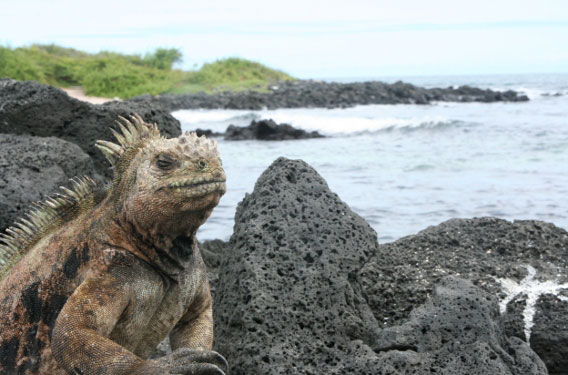Pressure Treatment
For iguanas, at least, too much of a good thing spells trouble when they’re stressed
By Helene Ragovin
What does it take to survive when things turn tough in the natural world? Why are some creatures able to withstand harsh conditions, while under similar circumstances, others perish?
Tufts biologist L. Michael Romero has been seeking answers to those questions, investigating the physiological effects of stress on wild animals. He studies what happens when animals experience assaults on their environment, from naturally occurring events like a famine to man-made calamities like an oil spill.

“What is it about these animals that is allowing them to survive?” biologist L. Michael Romero asks. Photo: Courtesy of L. Michael Romero.
In recent research on marine iguanas in the Galapagos Islands, Romero and his colleagues discovered that the ability to turn off the body’s stress response quickly appeared to be a key factor in whether individual iguanas survived a period of starvation—a finding that could have implications for humans.
The results from the iguana study surprised the scientists, who had hypothesized that the hardiest animals would be those that released the largest quantity of a hormone known as corticosterone, similar to the human stress hormone cortisol. Rather, it seems the iguanas that survived the famine were those that stopped producing corticosterone once a presumably optimal level had been reached. The ones that continued to pump out the corticosterone died.
“This was not what we expected,” says Romero, a professor of biology in the School of Arts and Sciences.
There might be a close connection to human response, too. The test used in the iguana study on the ability to turn off the stress response has also been used in people. “A very high percentage of people who suffer from depression and from post-traumatic stress disorder are also resistant to turning off the stress response,” Romero says.
A Care-Free Life
Unlike many other wild animals, the marine iguanas of the Galapagos face few sources of significant stress because they have just one predator—the Galapagos hawk, which only preys on very young iguanas—and a generally plentiful food supply of marine algae that grow in the cool, nutrient-dense waters of that portion of the Pacific.
The one primary stressor for the iguanas is the recurrent El Niño, Romero says. Every five to seven years, the islands are subject to the climate phenomenon when the trade winds cease to blow. The ocean heats up and the algae die off, leaving a certain percentage of the iguanas to die of starvation. (The number of iguanas that succumb during a particular El Niño varies, based on how long it lasts.)
With an average lifespan of 30 to 40 years, a Galapagos iguana could live through anywhere from four to seven El Niño cycles. “What is it about these animals that is allowing them to survive?” Romero asks.
Biologists usually can examine survivors of natural catastrophes only after the fact, but Romero had a plan, knowing the El Niños recur regularly. The researchers examined a population of marine iguanas on Santa Fe Island in the Galapagos shortly before the start of the 2002 El Niño to gather baseline information.
They measured the levels of corticosterone in the iguanas at rest and after being caught and handled—a physiologically stressful event. Then they injected the iguanas with a hormone that increases their release of corticosterone, bringing it to maximum levels. Lastly, they injected the iguanas with a synthetic hormone that lowers the level of corticosterone. The animals reacted either by stopping their corticosterone production—thus, shutting off the stress response—or continuing to release corticosterone.
Romero and his colleague, Martin Wikelski, from the Max Planck Institute for Ornithology and Konstanz University, returned in July 2003 after an El Niño, and found that 23 of the iguanas they had examined had died of starvation, while 75 survived. Those that died were among the ones that had been unable to halt the stress response and had continued to release corticosterone.
“We speculate the reason this is happening is that the hormone helps the body regulate energy flow, and helps mobilize energy for emergencies,” says Romero. “We’re thinking that when you have to cope with stress during starvation, you want to mobilize energy quickly—but not for too long—for just as long as absolutely necessary. Because then you start using up your energy reserves that you could have been using to survive the famine.”
There was no obvious external indicator of which iguanas were more likely to be able to control their release of corticosterone, according to Romero.
“It might be genetic,” he says. “It’s the same in humans. Different people have different individual abilities to turn off the stress response, just like the iguanas. And it’s not always ‘high-strung’ people. This is more like somebody with high blood pressure. You can’t identify who is better or worse at turning off corticosterone release unless you test them.”
Related story on Michael Romero’s research: “Paradise Lost”.
Helene Ragovin can be reached at helene.ragovin@tufts.edu.

